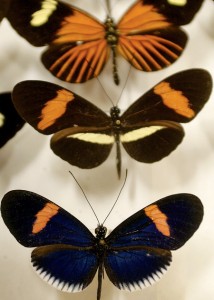Many people chase their dreams their entire lives. For more than 50 years, Ken and Donna Tidwell caught theirs—with nets.
The Tidwells amassed a collection of more than 35,000 butterflies from such countries as Bolivia, Costa Rica, Indonesia, and Mexico. In the fall of 2003, Ken Tidwell donated 6,451 mounted specimens to BYU’s Monte L. Bean Life Science Museum.

Thousands of brilliantly colored butterflies are now on display at BYU thanks to Ken and Donna Tidwell. Photo by Steve Walters.
The Tidwells developed a love for Lepidoptera—the scientific term for the order of butterflies and moths—while teaching Boy Scouts in the 1950s. They later taught entomology to the 4-H Club in Salt Lake County before joining the Lepidopterists’ Society.
Averaging three trips per year, the Tidwells meticulously researched the lives of particular butterflies before traveling to catch them with nets and traps.
The collection itself is a major addition to the museum’s collection, said Shawn M. Clark, ’79, arthropods collection manager.
“The specimens are aesthetically gorgeous,” he says. “They’re beautiful, and they’re here for people who might want to see them to come and examine them.”
“His is a valuable collection,” says Richard W. Baumann, ’75, curator of insects at the museum and professor of integrative biology at BYU. “It’s top quality.”
The collection includes many rare butterflies, such as aberrant specimens that have dynamically brilliant color patterns differing from butterflies of the same species, as well as the first intact specimen of a rare papilio swallowtail from Mexico.
Tidwell wanted the collection to be somewhere where it could be appreciated and loved. “He had seen the commitment that BYU and the museum had to natural-history collections,” Clark says. “He made the decision somewhere along the line that when he was retired and no longer able to get out and collect very much he would offer his collection to BYU.”
“That has been my desire,” Tidwell says. “They talked to me quite a few years ago about donating them.”
Tidwell may consider donating the rest of his collection to BYU as well. “They would have a hard time getting someone to mount all of them,” he says jokingly.








